The Friends of the Wildflower Garden, Inc.
Plants of the Eloise Butler Wildflower Garden
The oldest public wildflower garden in the United States

Common Name
Broad-leaved Helleborine (Helleborine, Helleborine Orchid, Poor Man's Lady's-slipper)
Scientific Name
Epipactis helleborine (L.) Crantz
Plant Family
Orchid (Orchidaceae)
Garden Location
Woodland and just outside the Garden in the marsh area.
Prime Season
Mid-summer flowering
Broad-leaved Helleborine is an introduced and naturalized invasive orchid. It is an erect perennial, growing on green stems from 1 to 3 feet high. Stems may be smooth near the base but are usually hairy in the upper parts, sometimes densely so.
The leaves are alternate, elliptic to narrowly lanceolate in shape, stalkless to clasping the stem, with an obtuse to pointed tip and a parallel vein structure. The surfaces may have some fine hair, the margins are smooth. Leaves are widely separated on the stem with the node forming a slight zigzag on the stem. They can be up to six inches long and half as wide. Most plants will have 3 to 10 leaves. Leaves progressively decrease in size from base to top - the upper stem leaves are much smaller, sessile, lance-like, reduced to bracts in the inflorescence.
The inflorescence is a 4 to 12 inch high terminal raceme of many stalked nodding flowers. Flower stalks are hairy. The raceme can be loosely to densely constructed with 15 to 50, 1/2 to 3/4 inch wide flowers but flowers tend to be on one side only. Each flower is subtended by a green floral bract that many times is longer than the flower.
Flowers: Orchids have 3 petals and 3 sepals with the petals taking on various shapes. Each flower of Helleborine is bisexual and has 3 sepals and 2 petals that are greenish and often with purple tinges of color, especially the two lateral petals, which are also slightly shorter than the sepals. These may also take on pink to yellowish tints. These are ovate in shape and abruptly pointed (acuminate). A third petal, lower, is enlarged with a modified shape to a shallow constricted bowl-shaped two-lobed lip, whose outer (front) edges are triangular-ovate. The inside of this bowl is glossy, deeply concave and purplish to brownish in color. The outer area is a greenish white. There are however some described color variations to these plants, sometimes described as separate varieties but generally considered to be ecotype variations. These variations are: White flowered, yellow flowered, albino form with white flowers, variegated form, and green flowered. Note that all will have some other color tinges. The reproductive parts of the flower are contained in a structure called a 'column' which is located inside toward the back of the flower and arching upward and curving forward over the lip. The ovary of this species is without hair. The calyx tube is green with fine hair and prominent darker green veins.
Seed: Fertile flowers produce a dry capsule that can be smooth to covered with fine hair. It contains many small dust-like seeds.
Invasive: Originally brought to North America from Europe as a medicinal or ornamental plant, it has spread far and wide. In Wisconsin it is listed as a restricted weed, but not in Minnesota. There are a number of recognized subspecies and varieties of Epipactis helleborine in its widespread, native range (Eurasia and northern Africa). Further, several forms of the species have developed in North America during its long residence here. Flora of North America (Vol. 26 - Ref.# W7) has more detail about that.
Habitat: Helleborine grows from short, thin but deep rhizomes and fibrous roots. It has adapted to most habitats but is usually found under the tree canopy. It springs up in gardens, path edges, lawns and disturbed areas, spreading widely from its small wind blown seeds.
Names: The genus Epipactis, is from the Greek epipaktis, a name used by the Greek Theophrastus (c.371 - c.287 BC), a successor to Aristotle and writer of botanical works, who used the name for a plant used to curdle milk. The species, helleborine, is taken from the Greek helleboros, the Greek name for the Lent Hellebore. Yes, somewhat obscure! In earlier times the plant was classified as Epipactis latifolia. The author names for the plant classification are first '(L.)' which refers to Carl Linnaeus (1707-1778), Swedish botanist and the developer of the binomial nomenclature of modern taxonomy. His work was amended by ‘Crantz’ who was Heinrich Johann Nepomuk von Crantz (1722-1799), Austrian botanist and physician. He has the genus Crantzia, named for him.
Comparisons: Prior to flowering the leafy stems may resemble some other orchids, but in our area there are not any confusing plants when this one is in flower as the only species that closely resembles this, Epipactis atrorubens, the Royal Helleborine, is found only in Vermont. The main difference there is that the ovary has fine short hairs, the lip is broadly triangular and the flowers are dark wine to cranberry red.


Above: Note how the leaves dramatically reduce in size from base to top of the stem. Drawing courtesy UW System - Flora of Wisconsin.
Below: 1st photo - Flowers are nodding and on one side of the 4 to 12 inch high raceme. 2nd photo - Leaves are stalkless to clasping and alternate on the stem. 3rd photo - Mature flowers forming seed capsules. Note the green bracts between each flower.
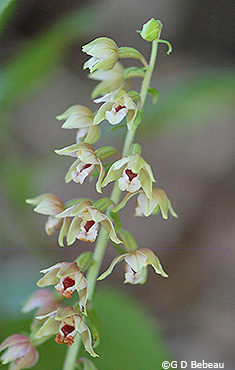
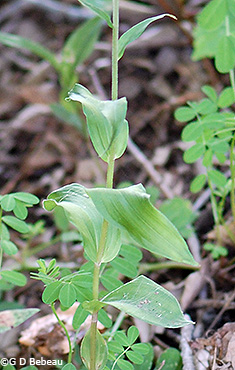
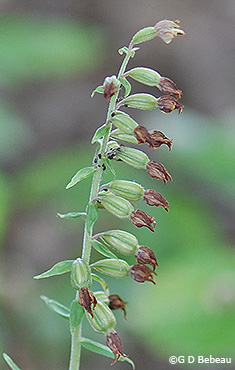
Below: 1st photo - The three sepals (outer most colored parts) are slightly longer than the two lateral petals. All five are colored the same. 2nd photo - The third petal forms the constricted bowl-shape with two forwarding spreading lips. The bowl inside is a glossy brownish-purple. Flowers are pollinated by bees and wasps.
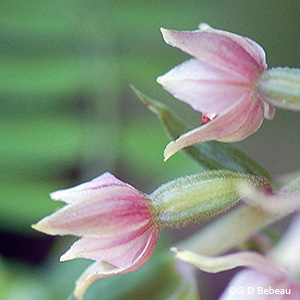
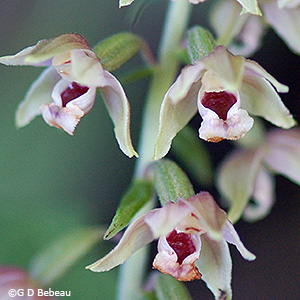
Below: 1st photo - The reproductive parts of orchids are contained in a structure called a 'column', which in the case of Helleborine, curves upward and forward over the lip from the back of the flower. 2nd photo - The outer calyx tube has prominent dark green veining. Note the leafy bract at the base of the stalk.
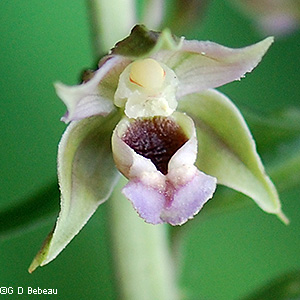
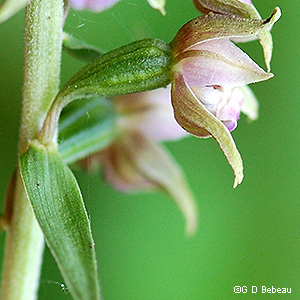
Below: The lower leaves are elliptical 2x as long as wide, with a parallel vein structure. Upper stem leaves are more narrowly lance-like, stalkless, reducing to bracts within the inflorescence.

Notes: Helleborine is found in North America in most of the eastern half except for the Gulf Coast of the U.S. It has also made its way to the West Coast and several Rocky Mountain States. Within Minnesota the DNR surveys have noted it in only 4 counties, Carver, Itasca, St. Louis and Winona. However its presence has been observed in others such as Hennepin. Its presence in the Eloise Butler Wildflower Garden was noted on the 2009 census and it has also been noted to be in the marsh directly north of the Garden.
For an article on all the orchids in the Garden, past and present, see this article.
Lore: While it is thought the Helleborine was brought to North America for either ornamental or medicinal purposes, there is little literature about it. By 1879 it was reported as well established in certain locales. Most herbal medicinal uses are associated with the Hellebores in the genus Helleborus. Gerard in his The Herball of 1597 (Ref.#6a) reviews three species of Helleborine including what he calls the "Wild White Hellebore", which is similar to the species discussed here. Of the three species he writes that "It is reported, that the decoction of wilde Hellebor drunken, openeth the stoppings of the liver or helpeth any imperfections of the same."
Return to -- Site Plan/Archive Index --or-- List of Common Plant Names -- or -- List of Scientific Names -- or --Home Page - - - Back to top.
References: Plant characteristics are generally from sources 1A, 32, W2, W3, W7 & W8 plus others as specifically applied. Distribution principally from W1, W2 and 28C. Planting history generally from 1, 4 & 4a. Other sources by specific reference. See Reference List for details.
 Identification booklet for most of the flowering forbs and small flowering shrubs of the Eloise Butler Wildflower Garden. Details Here.
Identification booklet for most of the flowering forbs and small flowering shrubs of the Eloise Butler Wildflower Garden. Details Here.
©2014
Friends of the Wildflower Garden, Inc. Text and photos are by G. D. Bebeau unless otherwise credited. "www.friendsofeloisebutler.org"
011518